Leaf-books and the Art of Writing
The process of writing in India started when letters, words and figures were drawn on sand or on a spread of grain. As time passed, other media came to be used. Blackboards with white chalk or white wooden boards with pieces of charcoal became common modes for expressing the written word. Kadatas or patas were used in religious institutions. These were made of a thick, coarse board or cloth plastered with the paste of tamarind seeds and other glues and finally painted black. The finished object was like a rolling blackboard on which details were entered meticulously with the help of a special chalk. Many religious institutions, like the matha of Sringeri, still boast of such ancient kadatas. These kadatas contain documents, accounts and housekeeping details, along with copies of royal grants, and declarations by royal preceptors and the pontiffs of the mathas.
© K. L. Kamat
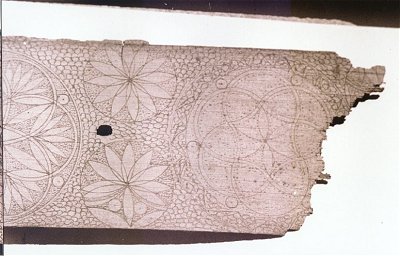
Pages from a Palm Leaf Manuscript
Bangalore University Collection, Bangalore
Commoners in medieval Karnataka, by and large, used processed palm leaves as writing material. These were then bound carefully in book form, and thereby rendered easier for transportation, preservation and exchange. Only old religious texts are now available in such book form. Most other palm-leaf books with illustrations on non-religious subjects and worldly topics have been lost. The Jaina holy texts, dhavala and mahādhavala may be considered the oldest and best preserved illustrated palm-books in Karnataka. They belong to the 11th century C.E.
Palm-leaf books were in vogue in India as far back as the 4th century C.E. Reference has been made in Buddhist texts to housewives reading them in the light of oil lamps in the evenings1. It is recorded that the tripithaka or holy Buddhist scriptures were written on palm leaves in the First Buddhist Conference (1st century C.E.). A few palm-leaves from a play written by Asvaghosa in the second century C.E. have been found. A Kannada composition called Vidagdha Chudamani, a commentary on the Amarakosha (lexicography), has survived for 850 years. A copy of the poet Pampa's Adipurana of 1379 C.E., on a palm-leaf book, is quite clear and readable till today. Such books clearly lasted for centuries when they were well preserved.
However, a lot of ignorance and superstition persists among the masses regarding palm-leaf books. In several households, they were handed down from generation to generation as an heirloom. Some householders believed that these contained details of their family property and income, and therefore did not want to part with them. Others, who could not decipher the alphabet, thought it was brahmalipi (mystic script) and therefore not to be tampered with. Some believed that trying to expose this "sacred" writing would bring bad luck. Thus several family members themselves were responsible for the ill-maintenance and eventual destruction of these invaluable old books. Covered in red cloth, these manuscripts ( hastaprati) were hardly dusted or dried in the sunshine over the years. Some were dumped in the dark attics of old mansions or establishments, to be slowly eaten by worms. It is due to this ignorance and indifference that several copies of rare books, classics and commentaries have been eternally lost.
In north India, birch-sheets or bhurjapatra were used as paper over the centuries. But in the south, including Karnataka, the use of palm leaves was widely prevalent as writing material, as palm trees grew and still grow in abundance in the entire belt. Like many other eco-friendly inventions of ancient and medieval India, the discovery of the palm-leaf as a writing-medium was highly practical. This particular palm-variety provides innumerable leaves, all the year round, which can be harvested at practically no expense! The palm tree grows about 30 meters tall and can bear 50 or 52 long leaves, each in the shape of a fan. It is strange that the tree, which provides neerā (fresh palm-beverage), tātinungu (tender sweet kernel), and toddy (liquor) also provides writing material to abstemious scholars for centuries! Well-grown leaves were cut periodically and supplied to workers who were adept in their processing and rapidly turned them into leaf-paper. Leaf processing involved three or four phases, as described below.
Palm leaves were first cut from the trees before they could dry up and become brittle. These were then boiled in water to the required temperature in order to render them soft. The softened leaves were then dried in the shade or mild sunshine. The desired portion was taken from mid-leaf, pressed and then polished. These were then cut into the required size and made into rolls of paper. Tālapatras or palm leaves of slightly yellow hew, eight angulas (inches) long, which were more brittle and hence cheaper, were given to students for copy work. The leaves of shritāla were a slight red in color and were 24 to 32 angulas in length. These were quite thin, soft and malleable. Such leaves were supplied to poets, scholars and writers.
There were professional palm-leaf paper-makers (˘leya kāyakadavaru) 2, who prepared ready-to-write ˘les or palm-leaves, and supplied them to mathas , basadis, temple schools and private individuals. These were sold in rolls ( kāttu) in village shanties as well3. Specially prepared preservative oil was applied to palm-leaf rolls before tying them into a book. Turmeric was often used to make the rolls colorful. Holes were made in the margins of these leaves, through which silken thread was passed and the leaves were carefully tied, and finally the book was ready!
© K. L. Kamat
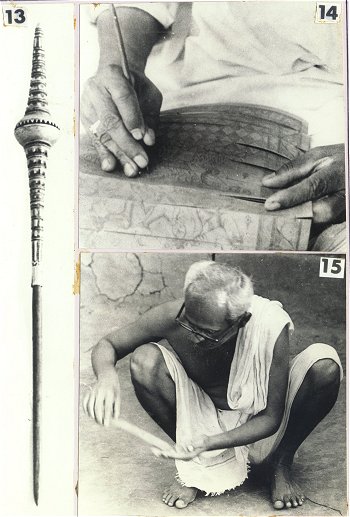
Palm-leaf Texts
A decorated steel pen (kanta):this was used to write on palm leaves(left).
Even the art of writing on these leaves is unique to India, and no ink or pen was required. A kanta or thick metal needle with a sharp point was used to inscribe or engrave letters on palm-leaves. These kantas used to come in various sizes. Students were given plain ones, whereas scholars were presented with bejeweled kantas (see picture no. 14). The kanta was to be held in proper position and the right pressure was to be applied, so that the leaf would not be torn. It is likely that youngsters destroyed many leaves in the process of learning how to properly handle the kanta. Good handwriting, being universally appreciated, inspired great effort in the development of clear, readable handwriting. Students were required to sit in a comfortable posture and inscribe diligently whatever the guru dictated. Just as in schools everywhere there were those students who were in a hurry to complete the ritual of writing and reading as well!
© K. L. Kamat
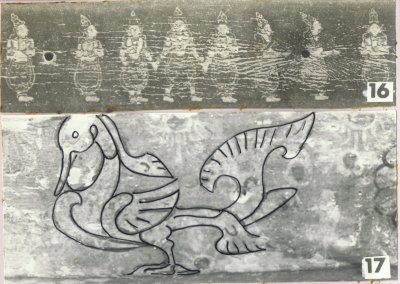
Pictures 16-17: Covers of palm-leaf text books
When the writing or copying of a manuscript was completed, wooden folders were placed above and below it, so that the leaves would not get crumpled or damaged. Thin boards were used for this purpose. These wooden holders were cut to the required size, were sometimes big and sometimes small, and often artistically decorated with floral designs and figures (see pictures 20, 21, and 22), just like the palm leaves they contained, which in turn had borders of floral designs. (The manufacture of wooden holders, wooden boxes and cane baskets to store these manuscripts and books created an ancillary industry). The wooden holders were polished with insecticide oils prepared from lacquer and minerals. Drawings and pictures on the cover board were based on the contents of the book.
K.L. Kamat/Kamat's Potpourri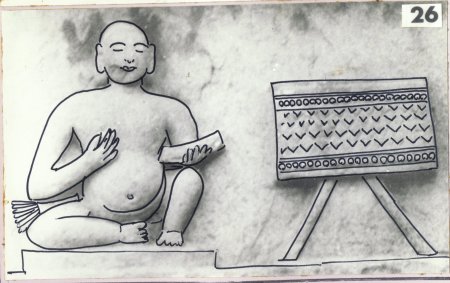
Jain Ascetic Shubhachandra
To the right is a box in which palm-leaf manuscripts are kept
Floral designs, animal and bird motifs were used for the borders of palm-leaf pages. Nature was depicted in her various moods. Shrivaishnava texts had the symbols of the shankha (conch), the chakra (wheel) and the nāma (red mark on forehead), which were associated with Lord Vishnu. A book on the Ramayana had the coronation picture of Lord Rama on the cover, or a depiction of the monkey brigade paying homage to Shri Rama. The Jaina texts would have sketches of various teerthankara s along with their symbols. Virashaiva texts were decorated with shivalingas and with sketches of Nandi (the sacred bull). With printing technology still years away, handwritten books were in great demand. Each sect had standardized the cover design as per the tenets. This helped readers and buyers to easily identify particular texts.
After inscribing the letters on the leaves, coal powder was applied, so that the letters were more conspicuous and therefore read more easily. Since correction or overwriting were impossible, great attention was required to make each leaf error-free. The holes made in the corner to tie the leaves got bigger with frequent use and therefore a sufficiently large margin had to be provided.
Good copyists were in great demand. One Rachchuka had such beautiful handwriting that women sought his help to write love letters. Somadeva Suri, the great Jaina scholar of the 10th century, availed the help of this Rachchuka, in writing (perhaps copying), his famous epic Yashastilaka4. Calligraphists enjoyed great respect in society. Kings, nobles and citizens honored them. Members of the royal family were also expected to develop good handwriting and learn different scripts.
© K. L. Kamat
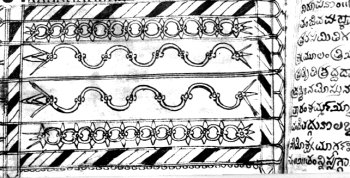
Decorated Chapter Separator of Ancient Textbook
This Jain text has designs made just with lines and small curves.
Poets kept ˘les and kantas ready all the time, so that they could scribble down ideas and phrases whenever these struck. If the writer and scholar had an indifferent hand, he could avail the help of scribes trained for the purpose. Copyists took their job seriously and started by inscribing the name of their personal god ( ishtadevatā) on the first leaf, prayed and only then started copying. Copyists moved from place to place with their rolls of palm leaves, kantas, and caskets of coal powder. People could at once recognize them on the streets and accorded a warm welcome. The copyists used small stools on which to place the leaves, squatted for hours, and diligently wrote on palm-pages one after the other until the assignment was complete. Various designs were drawn in the vacant space, if a particular leaf was half-complete. Trained writers used compasses to draw circles and semicircles to create accurate designs (see picture no. 22).
Books of smritis (code), purānas, the Ramayana, the Mahabharata, and the Bhagavata were given away to scholars for the purpose of reading out and interpreting in public discourses. This was undertaken to earn merit ( punya) 5, but it also helped in the spread of popular education. Every basadi or temple and matha had a specific time in the afternoon or evening to read or recite from books. Villages were sometimes granted to educational institutions, and the providing of books to scholars was one of the duties of residents in these villages.
Attimabbe, the great patron-saint of literature, is gratefully remembered today by naming the highest award for women writers after her. The Government of Karnataka instituted this award on the thousandth anniversary of her birth in 1996. Attimabbe patronized the great poet Ranna, who in his writings praised her munificence. She had one thousand copies made of poet Ponna's Shantipurana, a work dealing with the life and message of teerthankara Shantinatha, and distributed these copies among scholars. Jaina householders invariably arranged for the free distribution of palm-leaf books. Virashaivas followed suit in an even bigger way. Many philanthropists are remembered for distributing books of vachana literature and Shaiva holy-texts free of cost. Women were also active in producing copies of well-known religious texts for self-use and also to help others who read them out to groups. The names of women copyists figure in several manuscripts.
Copyists, known as lipikāras could be divided into three groups: some were appointed for the purpose. Others took to writing as a profession, and the third category was of amateurs who pursued it as a hobby or voluntary venture. The kings and administrators employed the first group. The second were self-employed and the third group practiced copying leisurely at home, in mathas or in other educational centers. Since the third group was not as qualified or experienced as the other two, grammatical and language errors crept in. However, scholars took care to compare the copied works with the original ones. A copied text always ended with a subhāshita (epigram) in Sanskrit .
"bhagna prishta katigrivā | baddhadrishtiradh÷mukham | kashtena likhitam shāstram | yatnena paripālaya", 6 meaning
"This shāstra was written with attention, straining neck and back, and downcast sight; preserve this piece with effort, I request.
Persian ambassador Abdur Razzak wrote in 1442 C.E. of a daftarkhānā (wing or annex of documents) where a number of writers were engaged to write down accounts on palm leaves. Duarte Barbosa, the Portuguese traveler expressed surprise at the scribes' briskness of writing with the kanta on long and rough palm leaves. Official writers had palm leaves with a royal insignia on them.
![]()
References
- Sukumar Dutt. Buddhist Monks and Monasteries of India, London 1962, p. 230, p236.
- Shivatattvachintamani of Lakkannadandesha, ch. 38, verse 78.
- Shasana Sahityasanchaya, p. 152.
- Yasastilaka and Indian Culture, p. 1.
- Agnipuranam, ch. 211, verses 53 and 54. (Puranam, Bharatamvaapi Ramayanamapi, cha, Likhitva Pustakam Datva Muktibhuktim Avapnuyat.)
- D. L. Narasimhachar, Kannadagramthasampadane, p. 51

